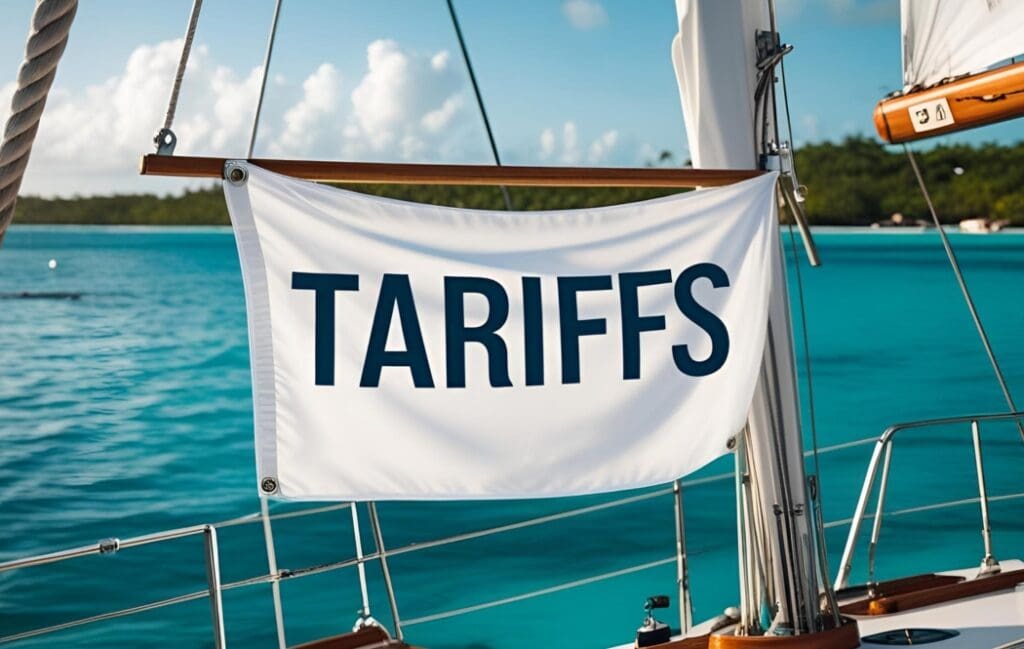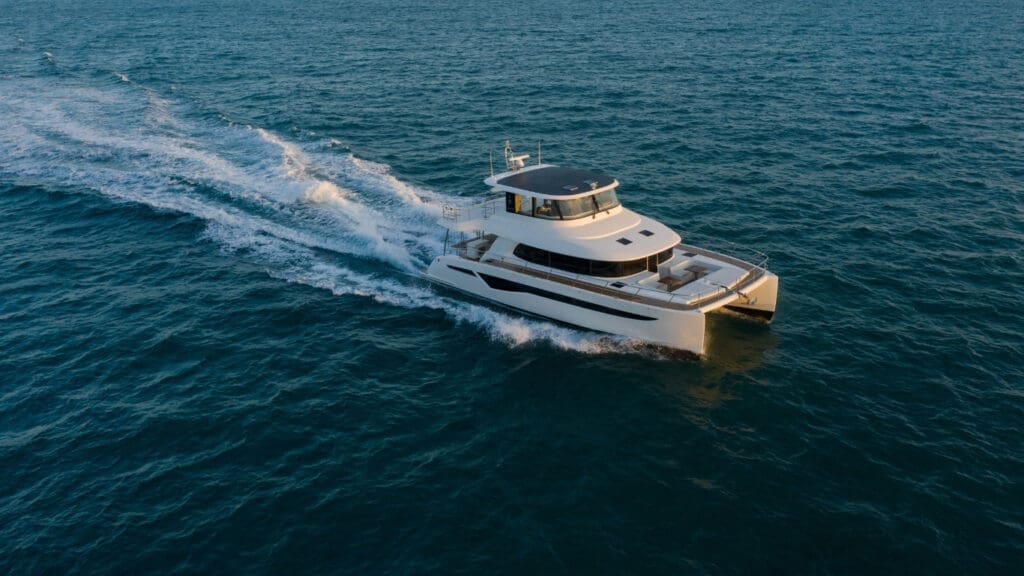The latest update on tariffs is that the U.S. has implemented a 15% tariff on boats imported from the European Union, up from the previous 1–2% rate and 30% on South African boats etc. For buyers considering a new yacht, this could mean paying tens of thousands more… unless you know the legal workaround. Many savvy owners are using a foreign-flag strategy and obtaining a U.S. Cruising License to legally cruise in U.S. waters without paying import duty. It’s 100% legal, commonly used, and incredibly effective.

Will Tariffs Cause Yacht Prices to Increase?
While increases are not confirmed from any of the manufacturers, tariffs will almost certainly raise prices on new European boats arriving in the U.S. later in the year. Boaters considering a purchase should know that future shipments will likely reflect the new tariff, making early decisions advisable.
However, despite the implementation of new tariffs, certain sectors of yacht ownership for U.S. buyers will stay unaffected. This includes our clients whose yachts are in charter programs for business purposes or are engaged in luxury crewed and bareboat charters in the Caribbean and Bahamas, an area where Catamaran Guru specializes. “These yachts will remain US-flagged but won’t be imported into the US as they operate in tax-free jurisdictions abroad,” Stephen Cockcroft explained. Read more here>>
For those yacht owners who choose to use their boats in the U.S. there are legal loopholes to avoid tariffs.
How to Avoid Tariffs on Yachts in 2025?
Many owners would like to use their yachts in the U.S. so, how do they avoid the tariffs? Yacht owners are successfully using a legal and well-established loophole to sidestep these import taxes by registering the yacht under a foriegn flag like Marshall Islands and then apply for a U.S. cruising permit. But avoiding tariffs or import duties on a foreign yacht in the U.S. requires a clear understanding of U.S. Customs and Border Protection (CBP) rules as well as maritime law. Below is a step-by-step guide of how to register under a foreign flag and obtain a cruising permit.

How to Register a Yacht under a Foreign Flag
- Foreign Flag Election: There are a number of good jurisdictions to choose from. Your Documentation agent should be able to advise you. We can refer you to really excellent agents.
- Establish Foreign Ownership: Best is through an LLC or offshore company but you could also use your own name
- Required Documents: Builder’s certificate, bill of sale, proof of ID, tonnage certificate.
- Registration: It is best to use a documentation agent but you can submit your application to the appropriate maritime authority or registry for your chosen flag jurisdiction. They may require inspections and a survey. Pay required registration fees which may vary. Keep your registration current by renewing it annually.
- Apply for U.S. Cruising Permit: Once the registration is done, apply for a cruising permit when entering U.S. waters.

U.S. Cruising License for Foreign-Flagged Vessels
Your yacht must be registered in a country with a reciprocal cruising-license agreement with the U.S. It can be registered under a foreign flag, such as the Bahamas, BVI, Marshall Islands etc. Once your yacht is registered, enter the U.S. under the foreign flag and obtain a cruising license from CBP, which allows you to enter U.S. waters without paying import duties. This license typically lasts for up to one year (renewable under some conditions). Conditions Apply:
- Charter is Off-Limits: No charters or paid guests are allowed. The yacht can only be used privately.
- Exit the U.S. Annually: You must leave U.S. waters after 12 months (e.g., go to the Bahamas or Mexico) for at least 15 days before applying for a new cruising permit.
- Not for Sale in U.S.: You can’t list the yacht for sale to U.S. residents while it’s in U.S. waters. If you want to sell it to a U.S. citizen, you have to either import the yacht and pay duty or conclude the sale outside U.S. waters
Step-by-Step Guide to Obtaining a U.S. Cruising License for a Foreign-Flagged Yacht
- Arrival at a Port of Entry – Check in with U.S. Customs and Border Protection (CBP) designated port of entry to declare the vessel. Request a Cruising License under 19 CFR § 4.94.
- Provide Required Documents: Vessel registration (foreign flag documentation)
- Proof of ownership / Registration
- Crew and passenger list
- Passport and visas for all persons on board
- Previous cruising license (if renewal)
- Pay Any Applicable Fees – Fees vary by port but are generally minimal.
- License Approval – If approved, CBP will issue the Cruising License, typically valid for up to one year.
- You may cruise freely between U.S. ports without filing additional formal entries
- You must still report arrivals and departures at some ports if required by local rules.
- You may not engage in commercial operations. No charter activities!
- When departing to a foreign port:
- Surrender the original registry and permit at CBP before leaving.
- After clearing foreign waters and spending at least 15 days outside the U.S., you may re-enter and apply anew for a cruising license
- Skipping the 15-day period or traveling outside while license is valid does not reset eligibility — CBP requires the vessel to actually exit and remain abroad for 15 days
We understand that the new tariffs may raise questions or concerns. However, it’s important to note that our strategy of foreign flagging is completely legal, widely used, and highly effective. This approach ensures that you’re not taking shortcuts but instead opting for a smarter route.
Many of our clients already prefer this method, and with the right guidance, the process is seamless. Whether you’re based in South Florida or the Northeast, foreign flagging offers clarity, flexibility, and significant cost savings.
If you’re considering a new Bali Catamaran, a GranOcean Powercat or a YOT Powercat, and wondering how to manage costs, rest assured that you can enjoy your yacht, spend time in the U.S., and avoid unnecessary financial burdens.
Want to learn more? We’re happy to connect you with legal and registration experts we’ve worked with.





